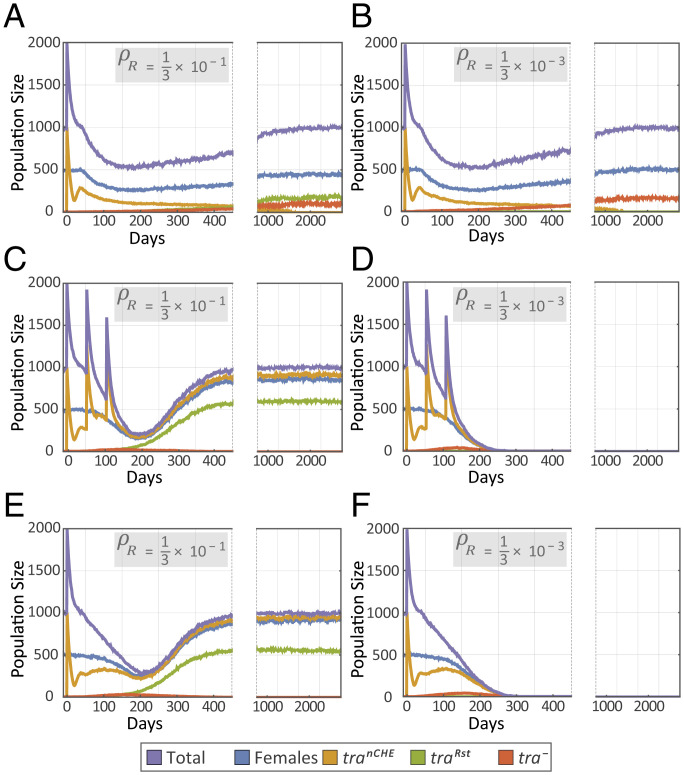Fig. 4.
Predicted dynamics of a Cas9-based homing system targeting the tra locus in C. capitata. Predictions are based on the population genetics model depicted in SI Appendix, Fig. S10 combined with the population dynamics model depicted in SI Appendix, Fig. S11 in which the life cycle of C. capitata is divided into four stages, egg, larva, pupa, and adult, with density-dependent mortality occurring at the larval stage (SI Appendix, Table S1). Homing occurs only in tranCHE/+ heterozygotes, where “+” represents the wild-type allele and “tranCHE” represents the intact drive allele. We assume a Cas9-mediated cleavage efficiency of 100% and a probability of accurate HDR following cleavage of 90% [NHEJ rate (δ) = 0.1]. By default, in-frame drive-resistant alleles (traRst) account for one-third of generated resistant alleles, although this proportion may be reduced through gRNA multiplexing. The remaining cleavage-resistant alleles are out-of-frame or other mutations that result in a tra−-null allele. The equilibrium population size of C. capitata is 1,000. Releases consist of 1,000 tranCHE; XY males at a single time or at intervals. In A–D, the scenario in which tranCHE; XX individuals are infertile intersexes is considered. (A) For a homing efficiency of 90% and an in-frame resistant allele generation rate (ρR = δθ, where δ is the NHEJ rate and θ is the fraction of NHEJs that produce in-frame indels) of one-third of 10%, a single release of 1,000 tranCHE; XY males results in temporary population suppression, halving the adult population size, with the population rebounding over a period of several years. (B) Decreasing the in-frame drive-resistant allele generation rate, ρR, by two orders of magnitude to 1/300 of 10%, and hence increasing the out-of-frame resistant allele generation rate, ρB = δ(1 − θ), to ∼10%, the population suppression is still only moderate and transient. (C) If three releases of 1,000 tranCHE; XY males are carried out in succession, the extent of population suppression is much greater (>75% suppression); however at a ρR of one-third of 10%, the population still rebounds over a period of several years with an increase in the frequency of traRst alleles. (D) If three consecutive releases are carried out for a construct with the decreased in-frame drive-resistant allele generation rate, population elimination can be achieved within ∼1 year after the last release. (E and F) The scenario in which tranCHE; XX individuals are fertile males is considered. For a homing efficiency of 90% and an in-frame resistant-allele generation rate, ρR, of one-third of 10%, a single release of 1,000 tranCHE; XY males results in temporary population suppression, as in-frame drive-resistant alleles become prevalent, preventing population elimination (E). However, if the in-frame resistant-allele generation rate, ρR, is reduced by two orders of magnitude, to 1/300 of 10%, the emergence of in-frame drive-resistant alleles is unlikely, and the population can be eliminated following a single release of 1,000 tranCHE; XY males (F).

